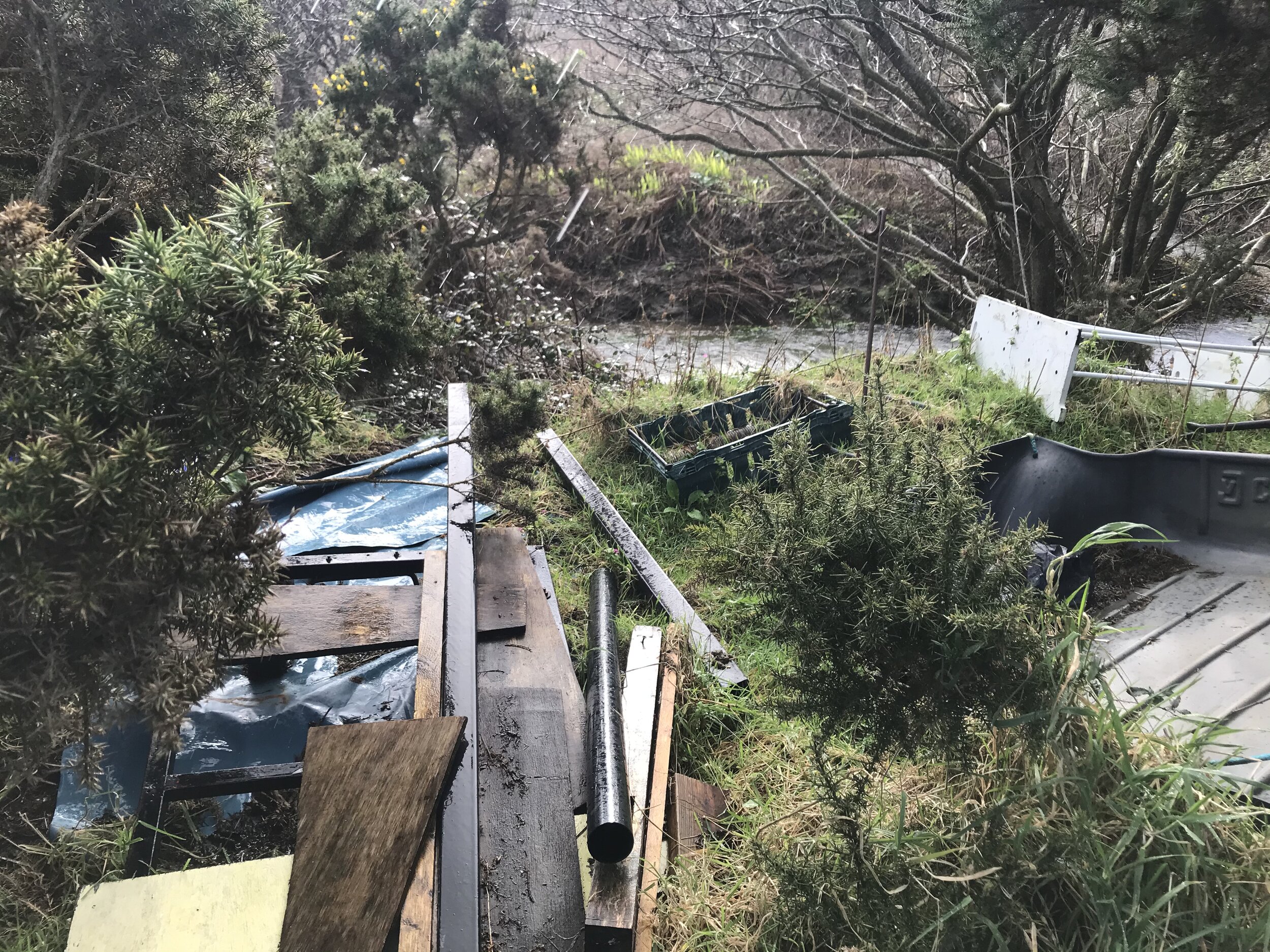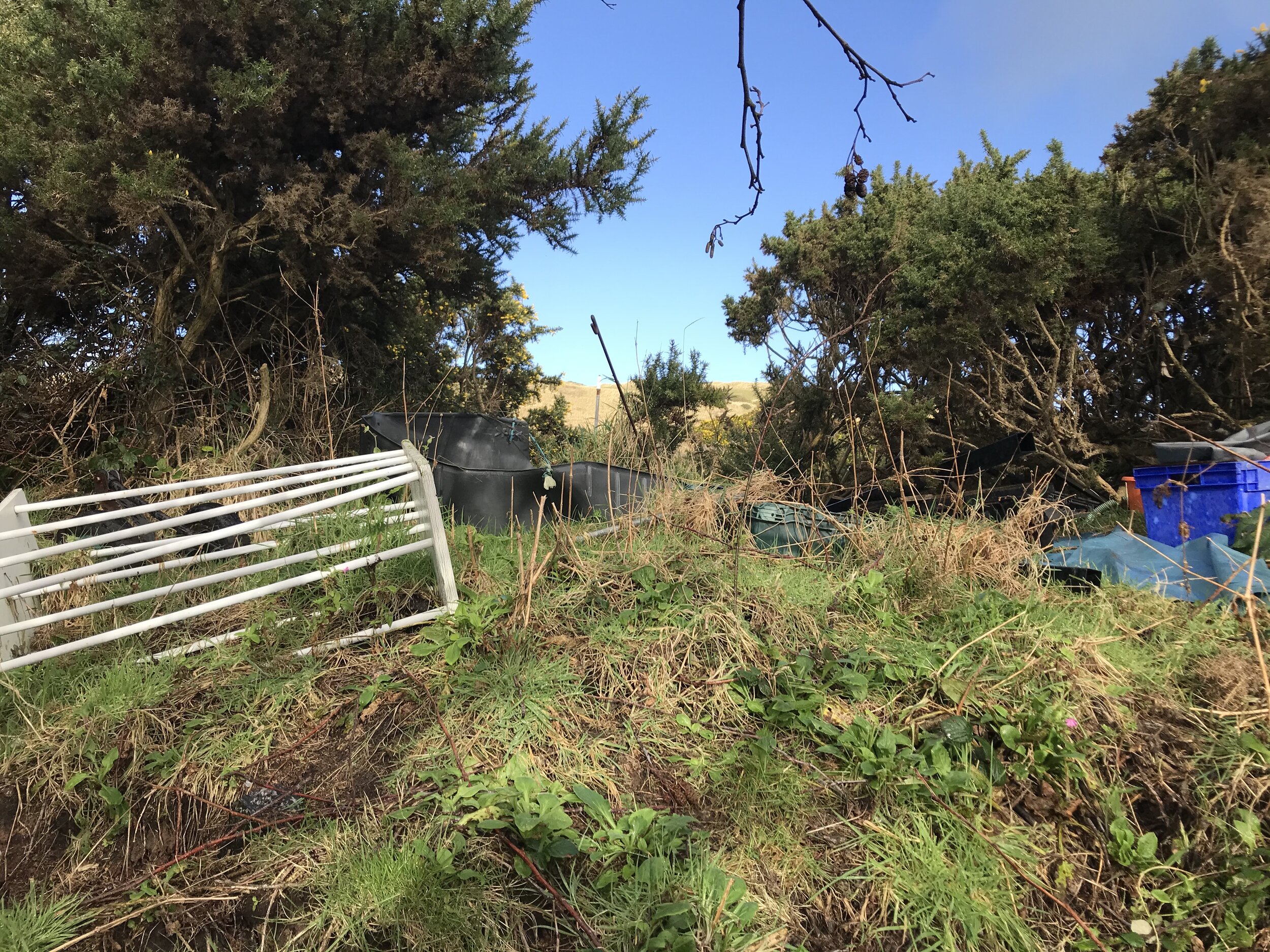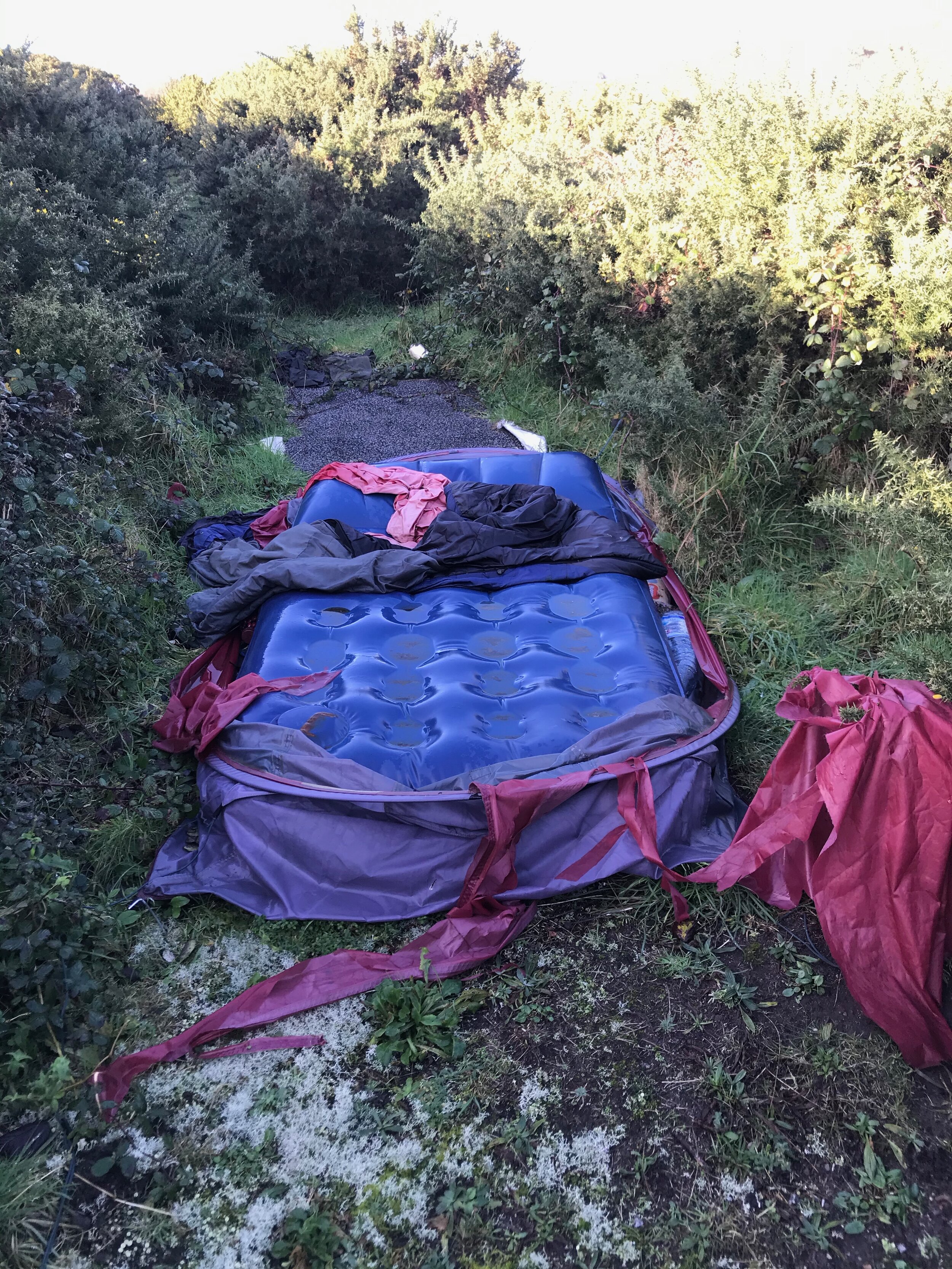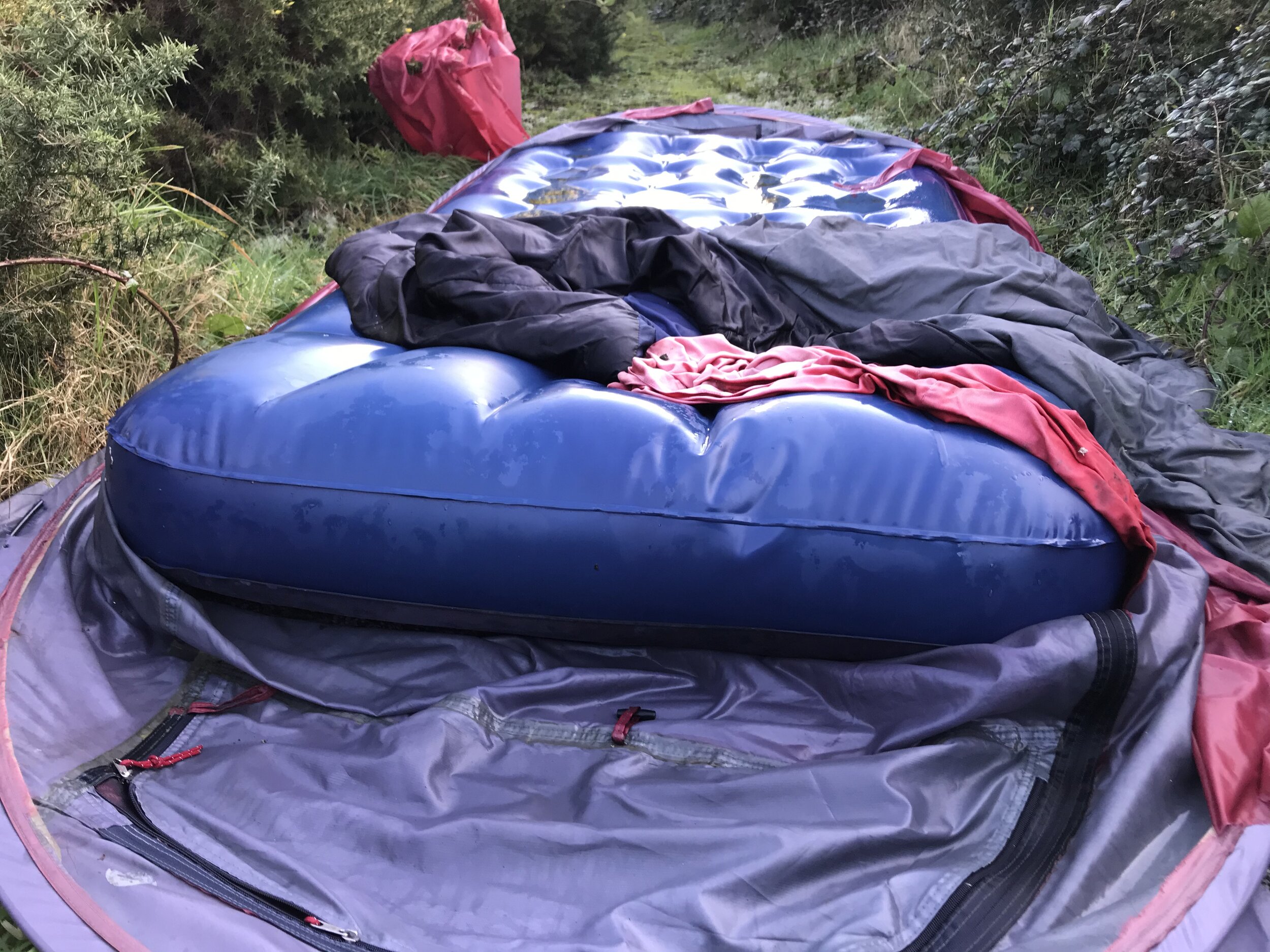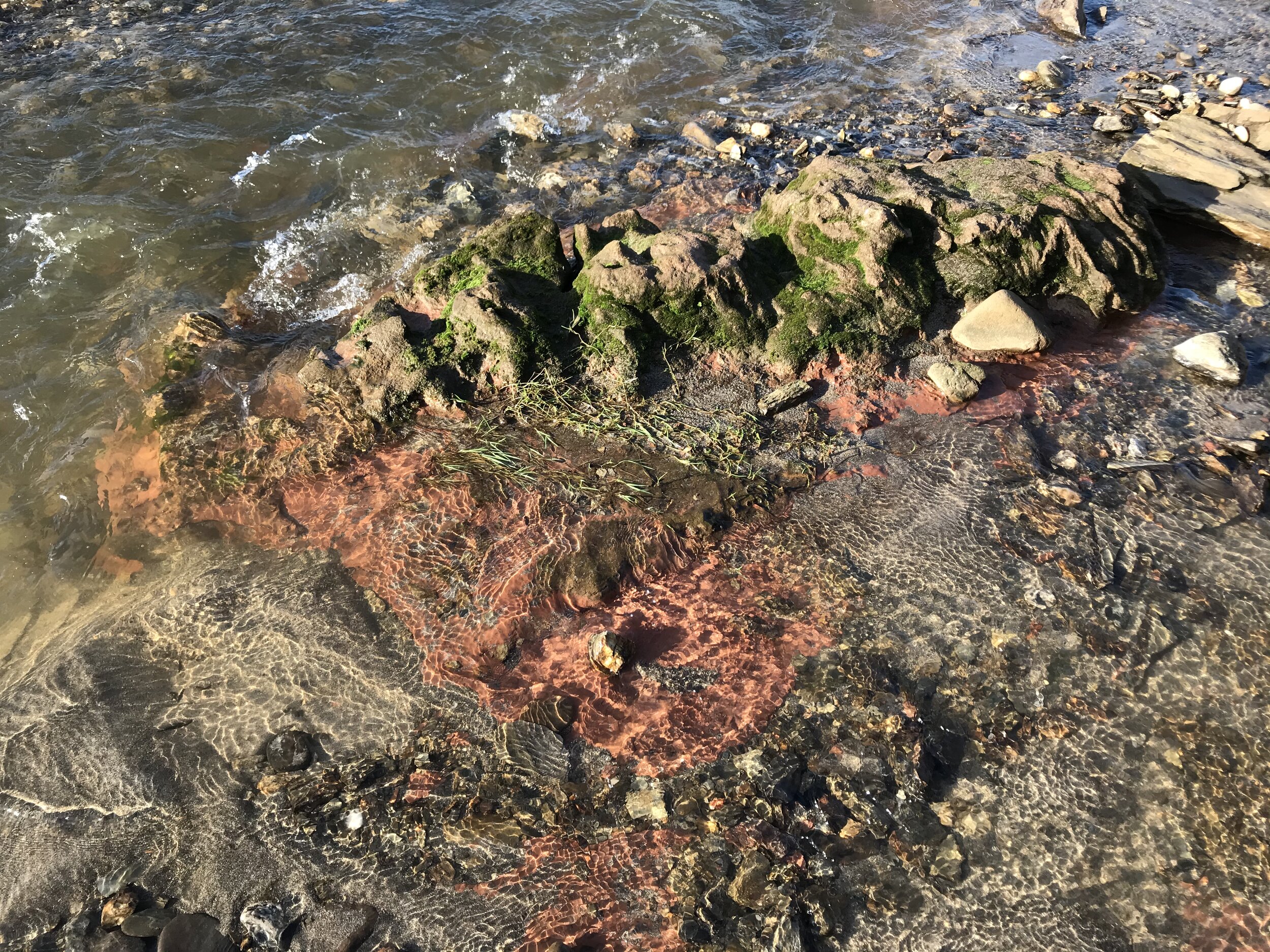AT THE MOUTH
My knowledge of the Red River began with the hump-backed bridge we’d beg dad to drive over as fast as possible. As we hit it, we’d be thrown in the air for a second’s weightlessness—no seatbelts then—before falling back to the sticky leatherette of the back seat. Now, here I am, forty-odd years later, on foot, trotting across it in front of an impatient car because the bridge is too narrow for the both of us. It feels very busy for the time of year; but then the St. Ives Bay area no-longer has dead winter months. A front of heavy rain has drawn a rash squalls in its wake, the January light striking them dark and turning rainbows out of the air: everyone’s out for a Sunday blow.
Once over the bridge, I veer across the road, climb a gate, and head up the valley in a renewed attempt to follow the Red River into the dense gorse that marks its route over the floodplain. I get further than last time, maybe because it’s winter, and maybe because a fly-tipper has reversed a tipper truck into the gorse before dumping the stuff I discover partly tumbled into the river. I climb over blue plastic tubs, a sign board, and what looks like a clothes dryer to get to the river, then hold on to a young sycamore to lean out and look upstream: no more than a couple of metre across, the river flows towards me, heavy and determined, its surface curling like heat from a furnace. Brambles trail over its surface, picking up brash as a record-player’s needle will pick up dust: they rise and fall on the warped, softly pleating, water. Shallow, belly-button-like eddies form and undo as its body snakes down between strict, man-made banks, towards the sea, where it will unbraid across the beach in acres of light. Travelling upthrusts bloom over and over as it hits some obstacle in its riverbed. I try to connect what I’m seeing with the apparently still water at Vincent’s Well, Bolenowe; I want to hold the river in my thought as continuous thing, but the water in rushes onwards, bringing me back to its emergence from the obscurity of gorse and crack willow.
I swing back in and go further upstream. The gorse opens for one last time around a piece of hardstanding, covered in moss, where someone has abandoned an encampment: an inflatable bed with a soggy sleeping bag turned, uninvitingly, back; and a coat on the ground beside it, like a sloughed of skin. I open the curled green jacket: its seams are lined with slugs and tumbles of woodlice; white mould has spread its hairy, ghost-skin deep into its fabric. There’s a faded MacDonalds cup pinned in the gorse, and some foil and bits of cellophane from cigarette-filter packs scattered on the ground. Not only is rubbish secreted along the banks of the Red River, it seems people, too, come here to be invisible.
*
How strange to be back at the mouth of the river, where, as a teenager, I’d wade through raw-umber mud, soft and shiny as paint fresh from the tube, to get to the rusty surf. All that remains of the mud is a seam of red clay apparent in the low cliff by the river’s edge. I break off a piece and rub it between finger and thumb in a river pool, the clay smokily dying the water red-orange before spilling out into the main current’s bright spine of water. I’m staining it with our past: I would to gaze out across the bay from Porthminster Point and watch the red slick from the river plume out and travel along the coast with the tides. I liked the stain it made on the pristine bay. Between finger and thumb I’m rubbing away at my nostalgia for an extractive industry central to Cornwall’s old identity; at the force and mystery of old technical innovations that were made in Cornwall; and at a fantasy of heroic masculinity I had no direct knowledge of, but which, nevertheless, gripped my imagination with its new shafts sunk, its opening up of old mines, its exposure of the raw and rare mineral garden deep under my feet.
And then the clay is gone. I stand and shake the water from my frozen hand. A child in a green coat on the other side of the river throws in a stone that clunks into the thinning water. A man kitted up by one of those Scandinavian-inspired outdoor shops of well-made and absolutely necessary things holds a brand new Tilly Kettle in his hand and beckons to his spaniels with another. There are kites in the distance beyond Strap Rocks and on toward the estuary at Hayle, perspective accumulating people into a thin crowd on the vast expanse of sand. Why don’t you get a proper job, an old voice mutters in me—proper job. I stagger the sand up to the National Trust carpark at Godrevy overlooking Virginia Woolf’s lighthouse, and then make my way past the packed cafe to the footpath bridge so that I can follow the river’s course down onto the beach.
It’s low tide. A big, messy surf is stacked up in a stationary, but ever-unrolling, wall of whitewater. I crouch down at the point where the river swings out, deflected by rock, and give myself time to look at my subject, this thing that has so much energy and disturbed life in it. What is it? How am I going to find words from its silence or that fit its silences with out reducing it to a fixed set of ideas. I know that language shapes the way I approach the river; but I also know I can use language in a way that opens the river’s strangeness back into me, disturbing and deflecting patterns of discourse with its surprising life. This is language as permeable membrane, as ecotone boundary, flexing to pick up the nutrients of difference and build them into its body. And through the strange vegetable commingling of language and thing that poetry attempts, it enters the breath and the pulse of our body, possessing us with the unlikeliness of our position in the flow of language and its witness to the ever-evolving world we are part of. I like to draw things I’m looking at. When it’s going well the challenging dialogue between eye and pencil will disclose new things in the field of vision and charge the marks made with the energy of a collaborative encounter between the seer and the seen: the drawing becomes a trace of attentive co-existence. My wife says I talk a good picture, let’s hope I can find a good poem. Blame the beach for windy, expansive, speculative thinking.
The river speeds out of its final bend and is cutting a miniature cliff in the sand and gravel opposite, eating into the smoothness of the beach, little bergs of sand calving and dissolving. A nest of bubbles in a hummock of water is made and remade and streams away from its travelling source to be stretched clear over the next, and smoother, pocket of turbulence. Make me ruck of water, I write in my notebook. I think of Elizabeth Bishop and her poem ‘The End of March’, in which she desires to ‘write down useless notes’ for hours in a ‘proto-dream-house’ I imagine to be similar to those perched in the nearby dunes across from where I stand. I’m full of scraps of notes. I think of St. Gothian (after whom Gwithian is named) whose chapel occasionally appears from under shifting sands, listening to wind and surf and breathing it out in her prayers; of how St. Ludgvan, not so far away, gazed into a stream and was granted the ability to see small things in infinite detail.
The dark clouds massed over St. Ives seem to relax their form and are suddenly upon us, seeking to overwhelm the sun. For a moment, the rainbow arching over Godrevy Lighthouse is doubled in a shivering mirror of wet sand. Phones the length of the beach are held outstretched between forefinger and thumb and the heavens scanned. I take my own snap, diminishing the space and scale of the rainbow, and head into the great sea roar as the rain sweeps across the beach extinguishing the vision and replacing it with another: the pebbles freckling dark, the sand pocked by the dull fizz of heavy drops. And now, soaked at the river’s mouth, where the sea slews in over its thin ending, I wait for the next surge to take in the Red River and roll it up in waves.


